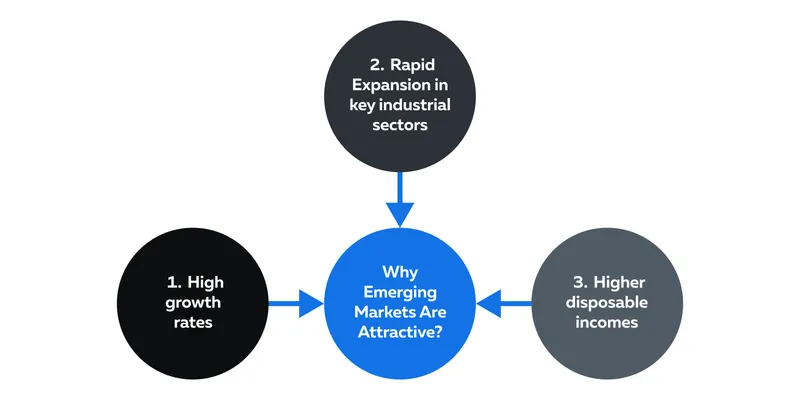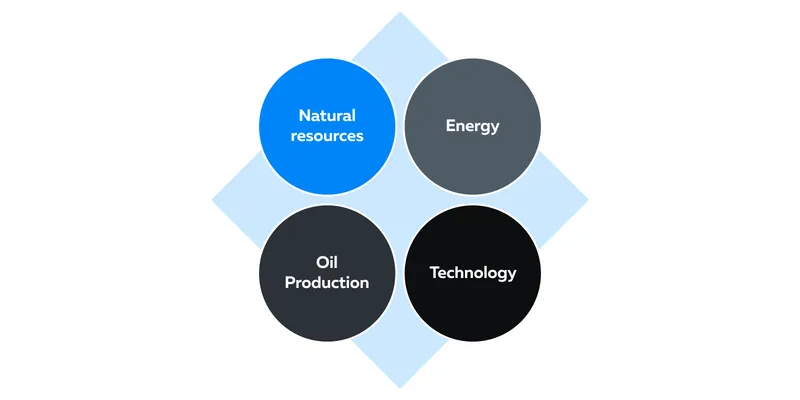

December Trading
Deals Are Live!
Save on Global+, data access,
and add-ons.
See All December Deals

Black Friday
Nov 28-Dec 31
15 days : 1 hours
50% OFF Global+ Quarterly
+ 50% OFF Data (3 months)

Cyber Monday
Dec 1 - Dec 31
15 days : 1 hours
60% OFF Global+ Monthly
+ Data (1 month)

Add-on Deals
Dec 1 - Dec 31
15 days : 1 hours
50% OFF
Add-ons

New Year Sale
Dec 26 - Jan 1
9 days : 1 hours
30% OFF Global+ Lifetime
*Data not included
Education
January 5, 2024
SHARE
Investing in Tomorrow: A Guide to Emerging Market Opportunities
Ever wondered how value investing works? It’s about putting your money in
fast-growing economies that offer good opportunities. In this article, we’ll
check out some up-and-coming markets that could be a goldmine for investors.
We’ll understand why they’re attractive to investors and the factors that
influence their growth.
Also, we will uncover the histories of key financial hubs, such as Brazil’s
B3, India’s National Stock Exchange, and the evolving markets of China.
Finally, we’ll guide you through a step-by-step approach to entering
emerging markets. Let’s get started.
What are Emerging Markets?
Emerging markets refer to economies that:
-
Are in the process of rapid industrialization and
-
Experience higher-than-average growth rates
Let’s see some common classification criteria:
-
GDP Growth:
-
Emerging markets typically exhibit a higher rate of economic
growth compared to developed countries. -
This growth is often fueled by industrialization, urbanization,
and technological advancements.
-
-
Market Accessibility:
-
Foreign investors can access and participate in these markets
with ease. -
Emerging markets often have fewer restrictions and barriers to
entry than more mature economies.
-
-
Economic Development:
-
While not as advanced as developed nations, emerging markets
show signs of progress in:-
Infrastructure
-
Education, and
-
Overall economic diversification
-
-
Why are Emerging Markets Considered Attractive Investment Destinations?

Emerging markets have historically demonstrated robust growth rates and
present attractive opportunities for investors seeking high returns. This
growth is fueled by factors such as:
-
A youthful demographic
-
Increased productivity, and
-
Capital investment.
Furthermore, investors are drawn to emerging markets due to the presence of
industries and rapid expansion in sectors like technology, renewable energy,
and healthcare. The emerging markets also witness the rise of the middle
class. As disposable incomes increase, consumer demand rises, creating
opportunities for businesses to thrive. This demographic shift contributes
to sustained economic growth.
Which Factors Influence Emerging Markets?
Emerging markets can be influenced by both micro and macro-economic factors.
Understand them through the table below:
|
Macroeconomic Factors |
Microeconomic Factors |
|
Political Changes
|
Infrastructure Development
|
|
Foreign Investment Policies
|
Regulatory Environment
|
|
Commodity Prices
|
Labor Market Conditions
|
Exploring The 3 Key Emerging Markets

Currently, investors recognize Brazil, India, and China as key financial
hubs and emerging markets. Let’s explore their sectoral growth trends, the
opportunities, and the challenges that define these dynamic economies.
The B3 – Brazil’s Beacon for Investors
The Backdrop – History & Role
-
B3, formerly known as BM&FBOVESPA, is Brazil’s main stock
exchange and financial market. -
Its history dates back to 2008 when two of Brazil’s major exchanges
merged:-
The São Paulo Stock Exchange (Bovespa) and
-
The Brazilian Mercantile and Futures Exchange (BM&F) in
2008.
-
-
The consolidation created a more comprehensive and efficient
platform for trading financial instruments. -
B3 plays a pivotal role as a financial hub for Latin America,
serving as a key player in regional capital markets. -
It provides a platform for companies to:
-
Raise capital
-
Facilitate trading in various financial instruments, and
-
Contributes significantly to the development of the Brazilian
and regional economies.
-
Trading on B3 – Securities & Sectors
B3 accommodates a diverse range of financial instruments, including stocks,
bonds, and derivatives. Notably, it is renowned for listing companies in
sectors like natural resources and energy. Brazilian multinational
corporations in these sectors often find a home on B3, providing investors
with opportunities for portfolio diversification. Let’s see some standout
sectors:

The natural resources and energy sectors are standout performers on B3.
Brazil’s abundant natural resources, coupled with advancements in
technology, make these sectors attractive for investment. The country’s
energy industry, driven by renewable sources and oil production, continues
to show substantial potential.
The Investor Landscape
-
B3 attracts a mix of domestic and international investors.
-
Institutional investors, including pension funds and asset
management firms, are significant participants. -
Global investors also seek exposure to Brazil’s economic growth and
diverse investment opportunities.
The Regulatory Environment and Barriers
The regulatory environment in Brazil has evolved. It now encourages
investment while maintaining market integrity. However, foreign investors
must be aware of taxation policies and foreign exchange controls.
Navigating the National Stock Exchange of India
The Backdrop – History & Role
-
The National Stock Exchange of India (NSE) has played a
transformative role in the Indian financial landscape since its
establishment in 1992. -
It was founded as a response to the need for a modern and
transparent stock exchange. -
NSE introduced electronic trading, replacing the traditional open
outcry system. This revolution helped in:-
Reducing transaction times
-
Minimizing errors
-
Enhancing overall market accessibility.
-
-
The introduction of the Nifty index, comprising 50 of the most
liquid stocks, has become a benchmark for the Indian equity market.
The Index Composition and Major Sectors:
The Nifty 50 index is a key barometer of the Indian equity market and
represents various sectors. See them below:

Product Diversity
-
The NSE offers a wide range of financial products.
-
In addition to equities, the exchange provides a platform for:
-
Trading derivatives, including futures and options
-
Debt securities, including government bonds and corporate bonds
-
Key Macroeconomic Drivers
The NSE has been influenced by India’s rapid digitalization. Increased
internet penetration and the growth of online trading platforms have
democratized market access, attracting a broader investor base.
Additionally,
-
Stricter compliance standards and governance norms have contributed
to increased investor confidence and transparency. -
There is a growing focus on sectors such as technology, consumer
goods, and healthcare to meet the evolving demands of the Indian
consumer.
Investing in China’s Evolving Markets
The Backdrop – History and Role
China’s remarkable economic ascent has significantly altered global
investment patterns. The country’s rapid industrialization, infrastructure
development, and technological advancements have positioned it as a major
player in the global economy. China’s growth has attracted international
investors seeking opportunities in one of the world’s largest and most
dynamically evolving markets.
The Regulatory Framework and Market Access Initiatives
China has taken steps to open its capital markets to foreign investors with
initiatives like Stock Connect. This program allows international investors to trade shares listed on the
Shanghai and Shenzhen stock exchanges. Also, the Chinese government has
implemented reforms to enhance market transparency and protect investor
rights.
Role of State-Owned Enterprises (SOEs) and Sectoral Growth Trends
State-owned enterprises play a significant role in China’s stock markets,
particularly in strategic sectors like:

Understanding the influence and performance of these entities is essential
for investors, as government policies can impact their operations and market
dynamics.
Further, it must be noted that China’s stock markets reflect the country’s
economic priorities. Sectors such as technology, e-commerce, renewable
energy, and healthcare have experienced rapid growth. Investors keen on
China’s evolving markets often focus on these sectors.
Impact of International Tensions on Market Performance
Let’s explore some of the major impacts and strategies to handle them
through the table below:
|
What are some major impacts? |
What is the meaning? |
How can global investors protect themselves? |
|
Geopolitical Considerations |
Trade disputes and geopolitical events cause market |
|
|
Sensitivity to International Factors |
China’s markets are highly sensitive to international |
|
Risks and Rewards in Emerging Markets
Emerging markets present a paradoxical landscape for investors. These
financial hubs offer substantial opportunities alongside inherent risks.
Let’s understand some common risks:
-
Emerging markets are susceptible to currency fluctuations. The
exchange rate volatility impacts the returns of foreign investors,
as changes in currency values can either:-
Amplify gains or
-
Exacerbate losses
-
-
Governance challenges, including corruption, inconsistent regulatory
frameworks, and political instability, are prevalent in some
emerging markets. -
Emerging markets exhibit thinner trading volumes and less developed
financial markets can create liquidity risks.
How to Approach Risks with Risk Management Tactics
Let’s understand some of the best tactics below:
-
Perform Due Diligence:
-
The investors must perform a thorough due diligence. This
includes a comprehensive assessment of the following:-
Regulatory environment
-
Political stability, and
-
The financial health of companies.
-
-
-
Practice Diversification:
-
The investors should spread investments across different:
-
Asset classes
-
Industries
-
Geographic regions
-
-
-
Employ Hedging Strategies:
-
Investors should implement hedging strategies to manage currency
risk. -
Instruments like currency futures or options can be used to
offset potential losses arising from adverse exchange rate
movements.
-
A Cautionary Note
Despite the allure of high returns in emerging markets, it’s vital to
recognize the flip side. Economic downturns, political instability, or
global shocks can have severe repercussions on these markets. Investors
should brace themselves for the possibility of significant losses and have
contingency plans in place.
How to Approach Emerging Market Investments
To minimize losses and formulate the best trading strategies, the investors
must be aware of how to approach emerging market investments. Let’s
understand through a step-by-step approach:
Step 1: Do Thorough Research:
Country Analysis: Begin with an in-depth analysis of the target country’s
economic, political, and regulatory environment. Evaluate the following
factors:
-
GDP growth
-
Inflation rates, and
-
Political stability
Sector Analysis: Identify sectors showing growth potential and consider:
-
Demographics
-
Technological advancements, and
-
Evolving consumer behavior.
Step 2: Perform Risk Assessment:
-
Political and Regulatory Assessment:
-
Assess the political stability and regulatory framework.
-
Evaluate the potential impact of government policies on your
investments.
-
-
Currency and Exchange Rate Risks:
-
Understand the currency dynamics and potential risks associated
with exchange rate fluctuations.
-
Step 3: Due Diligence on Investments:
Company Analysis:
-
Conduct thorough due diligence on specific companies or assets.
-
The investors must scrutinize:
-
Financial health
-
Governance practices
-
Competitive positioning
-
Legal and Regulatory Compliance:
-
Ensure investments comply with local regulations.
-
Understand legal obligations and potential risks associated with
regulatory changes.
Step 4: Select Investment Vehicles and Market Analysis Tools
ETFs and Mutual Funds:
-
Prefer utilizing exchange-traded funds (ETFs) and mutual funds.
-
These investment assets provide exposure to a basket of assets in
the target market. -
Through this selection, investors can manage risk via
diversification.
Bookmap and Other Analytical Tools:
-
Use advanced market analysis tools like Bookmap for real-time market
data and analysis. -
Such tools aid in understanding market liquidity and identifying
potential entry and exit points.
Step 5: Manage Risk:
Implement Hedging Strategies: Mitigate potential losses due to adverse
market movements by implementing hedging strategies, such as currency
hedging.
Continuous Monitoring:
-
Stay informed about:
-
Macroeconomic trends
-
Geopolitical developments, and
-
Changes in the regulatory landscape.
-
-
Always adjust your strategy based on evolving market conditions.
Conclusion
Emerging markets are an attractive destination for global investors. These
financial hubs present valuable opportunities for diversifying investment
portfolios and offer the potential for high returns.
Yet, caution is paramount, given inherent risks such as currency
fluctuations, thin trading volumes, and governance concerns. To navigate
these waters successfully, investors should adopt a long-term perspective,
embrace diversification, and engage in vigilant, ongoing monitoring.
Also, the usage of modern market analysis tools like Bookmap can help in
real-time visualization of market data that offers a competitive edge.
Looking to bring clarity to the complex landscape of emerging markets? With
Bookmap’s advanced visualization tools, gain unprecedented insights into the
global markets and harness the growth potential of Brazil, India, and China.
Sign up now and explore a world of opportunities.
